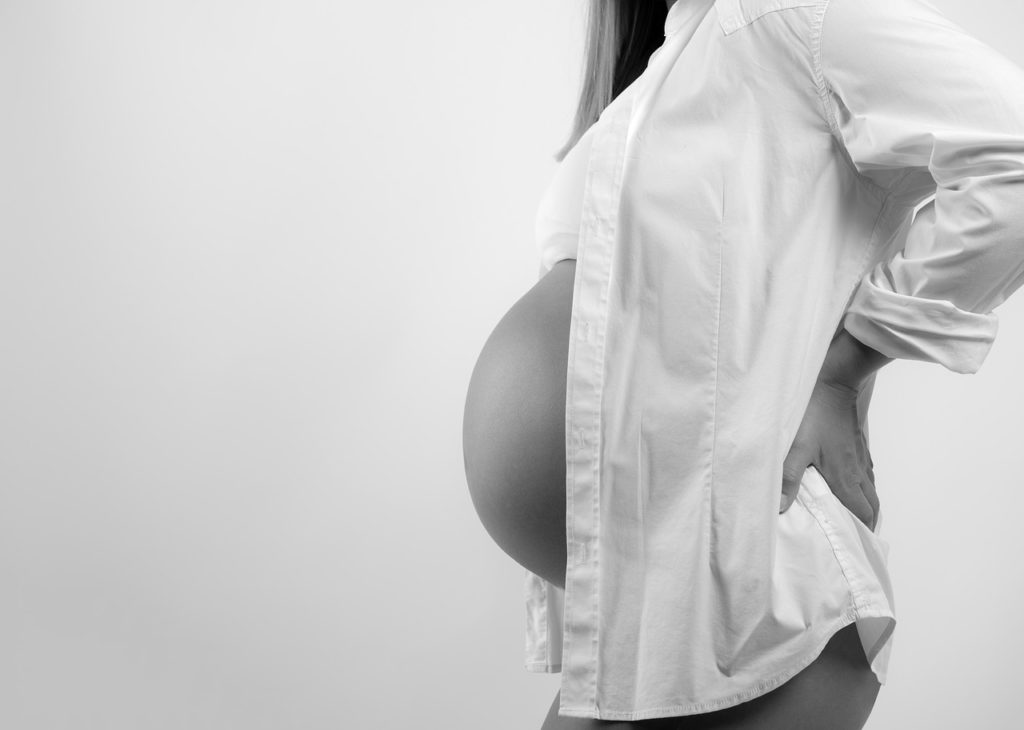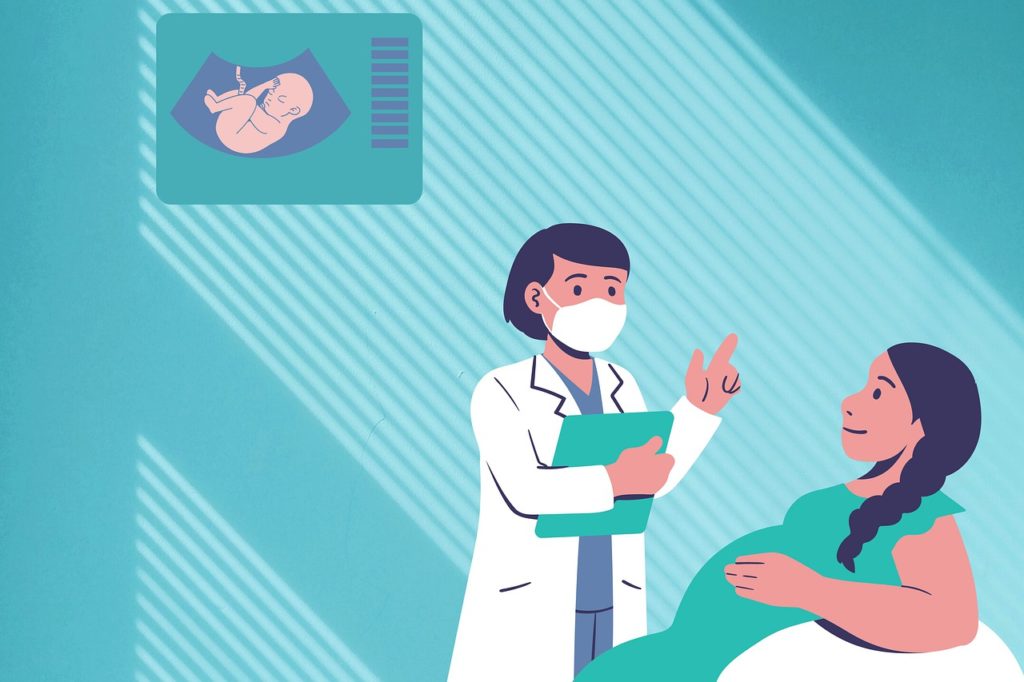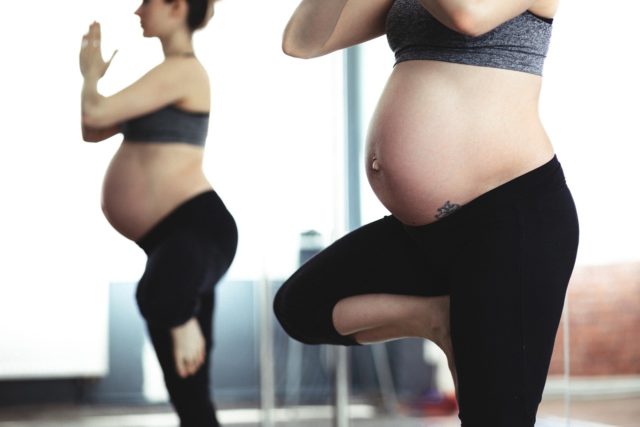Before I got pregnant, I already knew I had a herniated disc at L5-S1. It gave me enough trouble in my non-pregnant state, so when I learned I was expecting, I naturally wanted to know how the two conditions would interact.
I started reading up on herniated discs in pregnancy. Then, when things didn’t go as planned (more on that later) I tried to find a proper explanation. In this article, I review my findings from the literature, and go off on some tangents about my own experiences.
How common are herniated discs in pregnancy?
When I tried to come up with a number, I kept running across the same figure: 1 in 10,000. I finally traced this fact back to its source, a 1983 paper which reported on the rates of symptomatic lumbar disc herniations among all women who delivered at a single hospital in Michigan over a decade.
Out of 48,760 women who delivered there, 5 had suspected herniated discs. Each of these women was diagnosed based on symptoms and an EMG, although they did undergo x-ray scans after delivery. (LaBan, Perrin, and Latimer 1983)
Today, the diagnostic test of choice would probably be an MRI, but the paper’s authors make no mention of it. MRI technology was still new at the time, and I assume that they either did not have access to an MRI scanner, or there was no protocol for using it to diagnose herniated discs.
The article also didn’t break down the demographics of the mothers, so it’s not clear how they might differ from mothers today in terms of age, race, BMI, etc.
It’s unclear to me whether, if the study was repeated now, the results would be the same. The diagnostic criteria, and possibly the study population, would be different.
But, since I can’t find a better statistic, I’ll go ahead and cite the same figure everyone else does: 1 in 10,000.
Are herniated discs more common in pregnancy?
There isn’t any real evidence to suggest that pregnant women are more susceptible to disc herniations that non-pregnant women of the same age.
One oft-cited study from 1986 conducted MRIs on 302 asymptomatic women. As part of the study, they compared disc pathologies in pregnant and non-pregnant women, and failed to find any significant differences.(Powell et al. 1986)
The authors of a different paper summed up the evidence by saying, “There does not appear to be an increased prevalence of disk abnormalities in the gestational state, although lumbosacral disk bulges or frank herniations are not unusual in women of childbearing age.”(Laban et al. 1995)
In other words, pregnancy and disc herniations are both common conditions, so some lucky women will have both at the same time.
Such was the case of one 34-year-old woman, whose story was recounted in a 1997 article. The authors explained that she, “presented at 9 weeks’ gestation with severe left lower extremity pain that began after prolonged nausea and vomiting.”(Garmel et al. 1997)
Let me read between the lines: This woman spent her morning leaning over the toilet, trying her best to puke up a breakfast she could barely swallow in the first place. And all that forward flexion made her blow a disc. She ended up with sciatica and trouble peeing. If that’s not a pregnancy horror story for you, I don’t know what is.

What can you do about a herniated disc in pregnancy?
Ah, now there things get tricky. As far as I can tell, there are no official guidelines regarding treating a herniated disc in pregnancy. As you might expect, any suggestions involve a lot of hemming and hawing about the ethical difficulties of treating pregnant women, the importance of a thorough evaluation, and weighing of various risks.
Imaging
One paper from 2017 specifically reviewed the accounts of surgery on pregnant women with herniated discs, and tried to glean what lessons it could.
Despite the vagaries, and the authors’ understandable reluctance to draw definite conclusions, there was one point on which they were absolutely clear: an MRI should be the imaging mode of choice to diagnose herniated discs in pregnant women.
As the authors put it, “MRI represents the first level and safest diagnostic tool for pregnant women affected by spinal problems. It has been shown to be a safe procedure during pregnancy, allowing for a noninvasive and detailed radiological examination of the spine without exposing the developing fetus to the hazardous effects of ionizing radiation.”(di Martino et al. 2017)
Conservative Treatment & Medications
Not surprisingly, the authors say that conservative measures, such as rest and physical therapy should be the first choice in non-emergency situations.
If you are a pregnant woman in the US today, you probably already know that acetaminophen (Tylenol) is the go-to pain relief drug.
The bigger surprise (to me, anyway) was that the muscle relaxant cyclobenzaprine (Amrix) is generally safe to take during pregnancy.
Although there haven’t been any studies about its use in pregnant human women, rodent studies showed no issues for the mothers or babies until exceptionally high doses (≥3 the maximum human dose) were administered.(Teva Pharmaceuticals USA 2020)
Although drugs were never the most effective option for managing my sciatica, I did take cyclobenzaprine for a while, pre-pregnancy. It often helped the cramps calm down enough to allow me to sleep. I was surprised to see that a somewhat useful drug was considered acceptable during pregnancy.
Opioids and benzodiazepines are a whole morass that I won’t wade far into. Both do come with risks, as well as a heck of a lot of social baggage. Neither is entirely off-limits, although the willingness of providers to prescribe them may vary.
I will say this: I asked my maternal fetal medicine doctor for an emergency benzodiazepam (Valium) prescription during pregnancy, and he agreed. There were a few times (maybe four?) when my sciatica got so out of control that I took a 10 mg dose. Then I inevitably fell asleep.
I am 100% satisfied with that decision.
Surgery
In the presumably rare event that both the pregnant woman and her doctor agree that surgery is necessary, the menu of surgical procedures, and the criteria for selecting one over another, is the same as for non-pregnant women.
The authors of the 2017 paper did note that women who are in their late second or third trimester will probably need to be placed on a special frame during surgery, since it doesn’t really work to have them lay flat on their stomachs.(di Martino et al. 2017)
As for delivery, women who are near their due dates might choose to be induced or deliver by c-section.
In a few cases, surgeons have taken advantage of the anesthesia, and performed both spine surgery and a c-section while the patient was unconscious. However, in a true emergency (which usually means cauda equina syndrome), a surgeon might have to perform a spine operation before either patient or doctor can plan for delivery.
The accounts of back surgery on pregnant women are invariably case studies, a type of paper in which a doctor basically writes, “I had a patient who had X, so I did Y, and Z happened.” They are not trials, and they certainly aren’t randomized. This makes it impossible to say how the outcomes for procedures done on pregnant women differ from those done on non-pregnant women.
My Experiences with Herniated Disc Treatment During Pregnancy
The case reports and journal articles all have one thing in common: they’re written by doctors who are willing to treat pregnant women with herniated discs. Not all doctors fall into this category.
Story Time: Midway through my pregnancy, my sciatic nerve unleased a new level of wrath. I freaked out, and tried to find an actual doctor to help me. The maternal fetal medicine specialist I saw listened patiently, but back problems were not his specialty, and he didn’t know what to do.
I got kicked around to different departments for a while, and was finally referred to a neurosurgeon who specialized in spine surgery.
I tried to make an appointment, but the doctor’s assistant called me back, and said she wouldn’t schedule anything until after my due date. I argued that I really needed to be seen ASAP, since I suspected pregnancy was causing my current back problems.
No, the assistant explained. The doctor would want a CT scan, which he couldn’t prescribe if I was pregnant.
If he needed imaging, I asked, why not an MRI? Weren’t those supposed to be safe during pregnancy?
The assistant sighed, and told me in no uncertain terms that it wouldn’t matter. The doctor would not treat me while I was pregnant, so what did it matter if I got the imaging or not? My status as a pregnant woman was enough to disqualify me as a patient.
I’m not afraid to argue my case with a doctor (or a doctor’s assistant), and argue I did. But it was no use. The doctor would not see me, nor would he refer me to another specialist. My prescribed treatment was a big dose of Suck It Up and Deal.

Will pregnancy make a herniated disc worse?
Since I had a herniated disc before I got pregnant, my first question was whether pregnancy would make an existing herniated disc worse. If you’ve read this far, you already know that the answer (at least in my case) was yes. Naturally, my next question was, “Why?”
I’m afraid that science offers no definite answers, so I’ll have to wade into the nebulous waters of speculation.
When I first looked into back pain in pregnancy, I found some comforting evidence that women’s spines are well-adapted to pregnancy. I concluded that, since women tended to compensate for their changing center of gravity by bending backwards, and since bending forward is more likely to exacerbate a herniated disc, I would probably be fine.
But then, halfway through my pregnancy, my sciatica flared up to its highest point yet. Even using all my old tricks, and developing some new ones (such as sleeping on my stomach), I could barely manage the pain well enough to sleep. And even when I could fall asleep, I would wake up every few hours with debilitating cramps.
What’s more, this increased sensitivity persisted after I gave birth. I waited two months before I was able to lie comfortably on my back, and as of this writing, at four months postpartum, my nerve still seems to be on high alert.
So, I was left searching for a different answer. I uncovered a few theories and tantalizing pieces of evidence, but nothing that added up to a proper explanation.
One paper made the sensible observation that the increased weight in a woman’s abdomen would lead to greater compression of the intervertebral discs, which could in turn cause the nucleus pulposus to be expelled.(Sabino and Grauer 2008) This is basically what happens with a herniated disc in the first place, only with more force behind it.
As the uterus expands, the abdominal muscles also stretch out, which means they aren’t able to support the spine as effectively. The low back is forced to pick up the slack.(Sabino and Grauer 2008)
It also noted that the enlarged uterus can compress several important blood vessels, which may mean that the nerves are starved of oxygen. This could explain why some women (myself included) find their pain worsening throughout the night.
It’s a fact that joints become more flexible during pregnancy, and this is most likely due to hormonal changes. Although no one understand the precise role of each hormone, there is some evidence to suggest that this increased laxity leads to back pain. That could explain why some women develop back pain in their first trimester, before mechanical changes become much of a factor.(Casagrande et al. 2015)
There is also evidence showing that this increased laxity persists for at least six weeks postpartum.(Marnach et al. 2003) I find this explanation attractive, because it could explain why my turbocharged sciatica persisted for so long. At six weeks postpartum, my midwife confirmed that my uterus had shrunk back to its pre-pregnancy size, but my nerve didn’t seem to care.
Of course, this isn’t a multiple-choice question. It’s quite possible that multiple factors play a role, and specific combinations of changes serve to anger an existing herniated disc.
Conclusion
Hopefully, this article helps to de-mystify some aspects of herniated discs in pregnancy. Or at least, identifies the areas that are still shrouded in mist.
And if all else fails, remember: As a pregnant woman, you always have the right to complain.
References
- Sabino, Jennifer and Jonathan N Grauer. 2008. “Pregnancy and Low Back Pain.” Current Reviews in Musculoskeletal Medicine 1 (2): 137–41. https://doi.org/10.1007/s12178-008-9021-8.
- Casagrande, Danielle, Zbigniew Gugala, Shannon M. Clark, and Ronald W. Lindsey. 2015. “Low Back Pain and Pelvic Girdle Pain in Pregnancy.” Journal of the American Academy of Orthopaedic Surgeons 23 (9): 539–49. https://doi.org/10.5435/JAAOS-D-14-00248.
- Garmel, Sara H, Gail A Guzelian, Joseph G D’alton, and Mary E D’alton. 1997. “LUMBAR DISK DISEASE IN PREGNANCY.” https://doi.org/10.1016/S0029-7844(97)81422-6.
- LaBan, M. M., J. C.S. Perrin, and F. R. Latimer. 1983. “Pregnancy and the Herniated Lumbar Disc.” Archives of Physical Medicine and Rehabilitation 64 (7): 319–21.
- Laban, Myron M, Nadine S Rapp, Paul Yon Oeyen, and Joseph R Meerschaert. 1995. “The Lumbar Herniated Disk of Pregnancy: A Report of Six Cases Identified by Magnetic Resonance Imaging of Physical Medicine and Rehabilitation.” Archives of Physical Medicine and Rehabilitation 76 (5): 476–79.
- Marnach, Mary L, Kirk D Ramin, Patrick S Ramsey, Seak-Whan Song, Jacqueline J Stensland, and Kai-Nan An. 2003. “Characterization of the Relationship Between Joint Laxity and Maternal Hormones in Pregnancy.” Obstet Gynecol 101 (2): 331–36. https://doi.org/10.1016/S0029-7844(02)02447-X.
- di Martino, Alberto, Fabrizio Russo, Luca Denaro, and Vincenzo Denaro. 2017. “How to Treat Lumbar Disc Herniation in Pregnancy? A Systematic Review on Current Standards.” European Spine Journal 26 (Suppl 4): S496–504. https://doi.org/10.1007/s00586-017-5040-8.
- Powell, M C, P Szypryt, M Wilson, E M Symonds, and B S Worthington. 1986. “PREVALENCE OF LUMBAR DISC DEGENERATION OBSERVED BY MAGNETIC RESONANCE IN SYMPTOMLESS WOMEN.” The Lancet 328 (8520): 1366–67. https://doi.org/10.1016/S0140-6736(86)92008-8.
- Teva Pharmaceuticals USA, Inc. 2020. “Amrix Prescribing Information.” May 2020. https://www.amrix.com/globalassets/amrix/prescribing-information.pdf.
